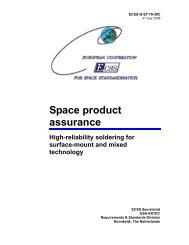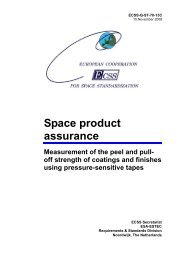ECSS-Q-ST-70-46C
ECSS-Q-ST-70-46C
ECSS-Q-ST-70-46C
Create successful ePaper yourself
Turn your PDF publications into a flip-book with our unique Google optimized e-Paper software.
<strong>ECSS</strong>‐Q‐<strong>ST</strong>‐<strong>70</strong>‐<strong>46C</strong><br />
31 July 2008<br />
3<br />
Terms, definitions and abbreviated terms<br />
3.1 Terms defined in other standards<br />
For the purpose of this Standard, the terms and definitions from<br />
<strong>ECSS</strong>‐S‐<strong>ST</strong>‐00‐01 and <strong>ECSS</strong>‐Q‐<strong>ST</strong>‐<strong>70</strong> apply.<br />
3.2 Terms specific to the present standard<br />
3.2.1 bolt<br />
cylindrical screwed bar provided with a head, generally not threaded along its<br />
entire length<br />
3.2.2 fail-safe<br />
NOTE For example: Shank plus threaded portion.<br />
approach in which the structure is designed with sufficient structural<br />
redundancy to ensure that the failure of one structural element does not cause<br />
general failure of the entire structure<br />
3.2.3 fastener<br />
device used to hold parts firmly together in an assembly<br />
3.2.4 galling<br />
condition whereby excessive friction between high spots results in localized<br />
welding with subsequent splitting and a further roughening of rubbing surfaces<br />
of one or both or two mating parts<br />
3.2.5 internal defects<br />
voids, cracks, inclusions, gross alloy segregation and indication of overheating<br />
3.2.6 nut<br />
metal collar, screwed internally, to fit a bolt<br />
NOTE Usually hexagonal in shape and operated by a<br />
spanner.<br />
9
















